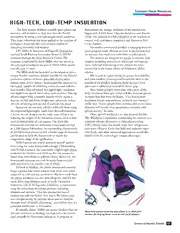
NASA Technical Reports Server (NTRS) 20020064734: High-Tech, Low-Temp Insulation PDF
Preview NASA Technical Reports Server (NTRS) 20020064734: High-Tech, Low-Temp Insulation
Consumer/Home/Recreation HIGH-TECH, LOW-TEMP INSULATION The fiery reentry of future reusable space planes can demonstrate the unique attributes of the blanket was receive a cool reception as they slam into the Earth’s begun with NASA Ames’ Disaster Assistance and Rescue atmosphere by using a new lightweight metal insulation. Team. Also planned is a full evaluation of the blankets in That same technology has been applied to the creation of concert with ambulance companies and American Red emergency rescue blankets and mittens capable of Cross chapters. thwarting extremely cold weather. Yet another commercial product is emerging from the S.D. Miller & Associates of Flagstaff, Arizona has space program work. Mittens are now in production that received Small Business Innovation Research (SBIR) are warmer than wool and made from recycled plastic. contracts through the Ames Research Center. The The mittens are designed for people in extreme cold company is operated by Steve Miller, who has served as weather, including recreational, industrial, and military the principal investigator on several NASA SBIR awards users. Informal field testing of the mittens has been over the past 11 years. carried out in the frozen climes of Antarctica, Miller The SBIR work has launched an investigation into a reports. unique flexible insulation blanket suitable for the thermal Silk is used as a glove lining for greater breathability protection systems of future spacecraft during atmo- and extra comfort. A waterproof/breathable shell on the spheric entry. A low-density, honeycomb-like material was outside of the product facilitates faster drying. Glove fabricated, capable of inhibiting convective and radiative palms use a rubberized material for better grip. heat transfer. This advanced, but lightweight, insulation Since hands perspire more than other parts of the was made from special metal alloys and ceramics. Shaving body, handwear often gets damp and this moisture greatly off any weight from a reusable launch vehicle means a increases heat loss from the hands. “Our honeycomb decrease in fuel and frame weight and, ultimately, lowers insulation doesn’t trap moisture, so hands stay warmer,” the cost of hurling each pound of payload into space. Miller says. “Active people from snowboarders to driveway Spacecraft are not only vehicles to benefit from using shovelers will benefit since perspiration increases with the improved lightweight, multi-layer thermal insulation. greater activity,” he adds. Current aircraft designs can be made more efficient by Other spinoff insulations are also deemed feasible. reducing the weight of the insulation system, such as that The Whirlpool Corporation is evaluating the material as a used in certain areas of a jet engine. The cloth-like moisture-tolerant alternative to chlorofluorocarbon honeycomb material can withstand temperatures as high (CFC)-blown foam that would make their refrigerators as 2,200 degrees Fahrenheit. An outstanding characteristic even more efficient. Units that hold and maintain super- of the fabrication process is that a broad range of materials cold fluids, and other industrial applications would also can be used to form the honeycomb to match the benefit from the technology’s unique advantages. temperature range of the application. Miller’s group saw several potential spinoff applica- tions using the same honeycomb concept. Collaborating with NASA scientists, the team made a lightweight plastic insulation for blankets and clothing that has properties better than wool fibers or polyester fleece. Better yet, the honeycomb structure can even be made from recycled milk containers—an excellent use of refuse. Utilized in blankets, the plastic honeycomb material keeps a person four times warmer than wool, even when subjected to cold and wet conditions. Blankets made from the plastic insulation are also non-allergenic, and dry five times faster than blankets made of wool. Thermalon Industries, Ltd. in El Segundo, California, is commercial- izing the technology in various products including blankets and mittens. “Our first production run of mittens was sold out before New Year’s. We believe they were bought mostly by extreme skiers and ice climbers through word of mouth advertising,” says Miller, who is a principal stockholder in Thermalon. Eventually, about 70,000 emergency blankets that use Material to protect reentering space planes is an ideal glove the new insulation technology are expected to be distrib- insulator for keeping hands warm in cold, harsh climates. uted annually by Thermalon Industries. A program to Commercial Benefits—Spinoffs 67
